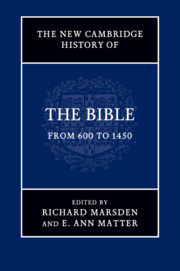Book contents
- Frontmatter
- Contents
- Figures
- Contributors
- Preface
- Abbreviations
- Abbreviations of books of the Bible
- Table of Psalm numbering
- Introduction
- Part I Texts and Versions
- Part II Format and Transmission
- 17 The Bibles of the Christian East
- 18 Carolingian Bibles
- 19 The Latin gospelbook, c. 600–1200
- 20 The Glossed Bible
- 21 The thirteenth century and the Paris Bible
- 22 Romanesque display Bibles
- 23 Latin and vernacular Apocalypses
- 24 The Latin psalter
- 25 Illustration in biblical manuscripts
- Part III The Bible Interpreted
- Part IV The Bible in Use
- Part V The Bible Transformed
- Bibliography
- Index of biblical manuscripts
- Index of scriptural sources
- General index
- References
19 - The Latin gospelbook, c. 600–1200
from Part II - Format and Transmission
Published online by Cambridge University Press: 28 May 2012
- Frontmatter
- Contents
- Figures
- Contributors
- Preface
- Abbreviations
- Abbreviations of books of the Bible
- Table of Psalm numbering
- Introduction
- Part I Texts and Versions
- Part II Format and Transmission
- 17 The Bibles of the Christian East
- 18 Carolingian Bibles
- 19 The Latin gospelbook, c. 600–1200
- 20 The Glossed Bible
- 21 The thirteenth century and the Paris Bible
- 22 Romanesque display Bibles
- 23 Latin and vernacular Apocalypses
- 24 The Latin psalter
- 25 Illustration in biblical manuscripts
- Part III The Bible Interpreted
- Part IV The Bible in Use
- Part V The Bible Transformed
- Bibliography
- Index of biblical manuscripts
- Index of scriptural sources
- General index
- References
Summary
In the Latin West between 600 and 1200, the four books of the Christian Gospels were copied more often and received more elaborate decoration than any other Christian text, except perhaps for Psalms. The importance given to the production of medieval gospelbooks – manuscripts containing the four Gospels and their associated texts – reflects the importance of the Gospels themselves in narrating the earthly life of Christ and the fact that they are the simplest expression of the ‘good tidings’ of salvation (Mark 1:1, quoting Isa. 61:1). During the medieval period, their texts appeared in many other types of manuscript, too, apart from gospelbooks. These include, obviously, Bible pandects and complete New Testaments, but also, because readings from the Bible were used in most forms of medieval worship, the Gospels were copied into various types of book used in the performance of the liturgy. In the daily round of services throughout the liturgical year, the use of a specific passage (pericope) assigned to each day had replaced the practice of reading the four Gospels sequentially from beginning to end (lectio continua) by the seventh century. Catering for this need were evangelistaries (also called gospel lectionaries or pericope books), volumes containing the full gospel readings for the Mass arranged according to the liturgical year, as well as readings from the Old Testament and the Pauline Epistles, all of which are written out in full for each Mass or Office. They became increasingly popular from the Carolingian period onwards. A few surviving sacramentaries, books setting out the words to be spoken by the priest celebrating Mass, also contain gospel readings.
Gospelbooks are among the most striking manuscripts of the Middle Ages. The texts were usually accompanied by introductory materials such as St Jerome's prologues, Eusebius' canon tables and chapter lists (capitula). The physical characteristics of the manuscripts varied considerably according to where, when and for what purpose they were made. They ranged from simply decorated and quite small pocket Gospels to large and imposing volumes with jewelled bindings. Their shapes evolved quickly from the roughly square codices of Late Antiquity into the rectangular form that remained customary through most of the Middle Ages. Their scripts in turn developed from Roman uncials through a series of permutations to the proto-gothic scripts of the twelfth century. Surveying the contents and uses of gospelbooks involves looking at such characteristics as their sizes, their bindings, the scripts in which they were written, the layout of the pages, the auxiliary texts included and the level of their decoration.
- Type
- Chapter
- Information
- The New Cambridge History of the Bible , pp. 338 - 362Publisher: Cambridge University PressPrint publication year: 2012

